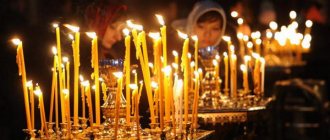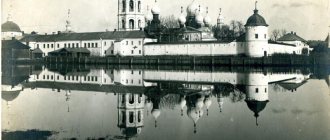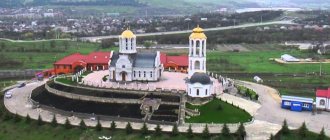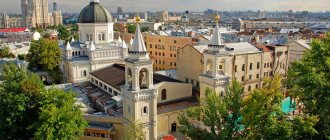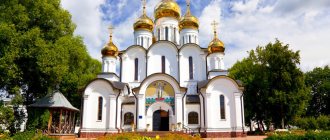Ancient legends living in the town of Kuremäe in Estonia seem to guard a majestic monastery, to which paths well-trodden by pilgrims lead for many centuries. Here it is Crane Mountain or Holy Place (Pühtitsa), on which the eternal abode rises. Her indestructible life was predicted by the holy prophets. On a high hill created by a glacier and the legendary figure of the Estonian epic Kalevipoeg, the domes of the cathedral froze, calling to itself. Thanks to the hero's strength, Crane Mountain, the largest lake in the immediate vicinity, was formed. As soon as they did not name the place of ritual actions of pagan gods, the Sabbath of witches in ancient times. Perhaps, indeed, the feet of a hero betrayed by his bride are buried under a huge trunk of a withered oak tree?
History of the monastery
It was under it, as legend says, that Estonian shepherds found the icon of the Dormition of the Mother of God, which predetermined the construction of the majestic monastery. The Orthodox Pükhtitsa parish was created on Estonian soil in 1885. Thanks to the initiative of the local governor, a women's monastic community was opened here in 1891. A few years later, a monastery grew out of it. The destructive historical events that swept over Estonia for several centuries in a row did not harm this amazing Orthodox complex, which is of interest to countless tourists. The monastery has always remained active. Since 1990, the monastery has been under the canonical control of the Patriarch of Moscow and All Rus'.
View of the Pyukhtitsa monastery designed by M.T. Preobrazhensky, 1892
Initially, a small chapel was built at the location of the icon. It contained the icon found before the construction of the main Assumption Cathedral. The architectural complex of the convent was built according to the design of M.T. Preobrazhensky.
Construction of the Holy Gates. In the background is the first Assumption Church. 1892
Pilgrims begin their acquaintance with the complex by walking around the oak tree three times. Next to it is the oldest building of the ensemble, the wooden Church of St. Nicholas the Wonderworker, standing in the cemetery where the sisters are buried, whose graves are marked by a neat row of metal crosses.
It now includes the following buildings:
- The five-domed Assumption Cathedral, built in 1910. It is the main temple adorning the complex of monastery buildings. Among the main shrines, along with the icon found under the domes of the temple, there are icons of the Mother of God of Vladimir, relics of saints, and other valuables. The road to the temple passes through the Holy Gate, built in 1895 in the form of a quadrangular stone building ending in a tent. They are always open. There is an opportunity to take a quiet walk around the complex.
- Simeon-Anninskaya Church, erected (1895) There is a refectory in it. Next to it are the famous woodpiles of Pyukhtitsa. Stacked firewood looks like haystacks. They complement the ancient spirit of the holy place on Crane Mountain.
- Sergievskaya Church.
- Hospital building. According to the ancient monastic tradition, here and now they provide shelter for wanderers. They are fed for three days, provided with free overnight accommodation, and then on the basis of cooperative obedience.
- Doctor's house. A local hospital was formed on the territory of the monastery in 1895. At that time, rural areas did not have their own doctor. Medical care provided in the monastery was an important area of its activity. At the hospital there was an orphanage and a hospital. Since 1996, the building has housed a library and archive.
- Holy spring. The healing properties of the water that appeared on the mountainside have been known for a long time. From all over Estonia and neighboring countries, people are rushing here for help. They drink the holy water of the spring, plunge into its icy freshness behind the walls of the equipped cozy bathhouse.
- Baptismal temple. The baptism ceremony is performed on weekends for children under 15 years of age and adults. During the ceremony, the nearest Christian name is chosen according to the calendar. It will protect a person all his life.
Temple shrines
On the territory of the monastery there are many revered icons, as well as a font. People come from different countries to take a dip in holy water.
Spasov key
One of the main shrines of the monastery is a source of spring water. Amazing healings of people from various ailments still occur there.
Some of the miracles performed:
- Under Abbess Varvara I, a girl who had lost her sight after a serious illness was healed. In gratitude, the mother left the child in the monastery for a year, but then the girl began to go blind again. Returning, the woman prayed for a new miracle, and her request was granted. After this, she blessed her daughter to stay in the monastery for life.
- In the thirties of the 20th century, the temple was visited by the family of an English lord. His daughter was paralyzed and was taken to the source on a stretcher. The girl returned on her own. After this, the whole family converted to Orthodoxy.
- At the same time, on the eve of the celebration of the Tikhvin Icon, I. G. Pinus arrived at the monastery. After the service, his whole family went to Spasov Klyuch. A boy came running before everyone else and saw an image of the Mother of God. Soon the adults came up and also received a wonderful vision. It was so clear that at first everyone thought it was a mosaic at the bottom of the tank. Taking a closer look, people noticed that the image was see-through. The next day, a prayer service was served at the source, but the image had already disappeared. I.G. Pinus, amazed by the miraculous phenomenon, built a stone chapel instead of a wooden one.
- In the late eighties of the 20th century, an American visited the temple. Later it turned out that he took with him a small bottle of spring water and gave it to his sick sister, who was bedridden, drop by drop. A miracle happened and the girl recovered.
A wooden bathhouse was built not far from the chapel. All year round, people have the opportunity to plunge into the waters of the holy spring (it does not freeze in winter). As pilgrims say, it relieves fatigue and gives peace of mind. Over the years there have been many cases of healing, including from cancer.
Icon called “At the Source”
The history of the image is connected with the name of the holy righteous John of Kronstadt. He looked after the sisters of the monastery, like his own father. Helped spiritually and financially. The great shepherd was a welcome guest, everyone hoped for his support and prayerful help. The nuns presented him with the miraculous icon as a gift on Angel's Day. It is with her that the appearance of the Mother of God to Archpriest John is connected. Nowadays, a luminous image greets everyone entering the cathedral.
Pyukhtitsky Assumption Convent today
You can visit the famous place of Estonia in the form of a pilgrimage for persons of both sexes, an excursion through the territory of the monastery, hidden behind ancient stone walls with four towers. Nuns conduct tours of the monastery, revealing the secrets of the most mysterious places of the five temples of the monastery complex, showing their inner beauty. You can order it in advance. The country's active landmark hosts various types of church services. Anyone can take part in them. The work associated with caring for the beautiful buildings and the adjacent monastic garden is carried out by the sisters and parishioners with high quality, carefully in the old traditions of the country.
You can take advantage of numerous offers from travel services by paying for a sightseeing tour. It includes acquaintance with the six temples of the complex, the cemetery church in the name of St. Nicholas, St. Arseny the Great, the refectory, and the Holy Spring. Visit the memorial premises of the monastery museum, equipped in honor of John of Kronstadt. He supported the monastery, helping the servants financially and morally. He took part in the celebrations on the occasion of the consecration of the main church of the monastery. His personal belongings are kept in the museum as a priceless holy gift to the monastery. Having reached the top of the mountain, you can see a wooden temple erected in the name of Sergius of Radonezh. Nearby is the grave of the founder of the monastery, the famous Prince S.V. Shakhovsky. Of great interest is the story about the life of Patriarch Alexy II, whose career began within the walls of the famous monastery from 1950 to 1958.
Architecture and decoration
Currently, the Assumption Cathedral is the main church of the monastery.
Appearance
The building is an interesting architectural landmark.
Technical characteristics of the temple (in meters):
- height - 38.4;
- width - 21.3;
- dyna - 40.5.
Initially, the building was in the form of a cross, but then side wings were added to it, and the shape changed to square. Nearby there are two chapels: in memory of Saints Isidore and Nicholas the Wonderworker. The roof is decorated with central and side towers with gilded crosses on them. The quadrangular bell tower adjacent to the cathedral gradually turns into a sharp long spire.
Interior design
The cathedral has three altars.
Side chapels:
- The main one is dedicated to the Dormition of the Mother of God.
- The right one is to the Venerable John Climacus and Seraphim of Sarov.
- Left - to the Holy Great Martyr Demetrius of Thessalonica, the Myrrh-Streamer, and Nicholas the Wonderworker.
The main decoration of the Assumption Cathedral is the icon of the Mother of God, the history of which is miraculously connected with the name of the holy righteous John of Kronstadt. In 1894, the nuns painted and presented on the day of the Angel to their beloved shepherd an icon depicting the appearance of the Most Holy Theotokos at the source. This image remained with the shepherd until his death.
How to get there
The village of Kuremäe is located in the north-eastern part of Estonia. A distance of about 30 km separates it from the Russian border. Bus routes organized from Tallinn operate twice a week. In addition to them, people come to the monastery by intercity bus going to the city of Jõhvi. The further trip is made by suburban bus No. 116. He makes trips to the monastery 8 times a day.
When traveling to Estonia by train, for example Moscow-Tallinn, you need to get off at Jõhvi station.
Interest in the monastery increases every year. Despite the fact that the number of women who decide to devote their lives to him is decreasing, the established conditions, order, and ritual actions do not change. The ancient prophecy about his eternal life on the Holy Mountain of Estonia continues to come true.
Links[edit]
- Cooperation in the Pukhtitsa Monastery
- Estonian Orthodox Church
- Pyukhtitsa in Kuremäe. VKontakte page
- Pyukhtitsa Stavropegial Holy Dormition Convent
- Unfortunately, very few people now go to the monastery
- Pukhtitsky Assumption Convent in Estonia
- Pyukhtitsa Monastery
- Pyukhtitsky Assumption Stauropegial Convent. Estonia
- Estonia. Pyukhtitsa Orthodox Convent
- Pyukhtitsky Assumption Convent
- Pyukhtitsa Monastery: Three steps to the Kingdom of Heaven
- Pilgrimage trip to the Pukhtitsky Assumption Convent
- Pyukhtitsky Assumption Convent
Photo
Pilgrimage to the Temple
Men can also make a pilgrimage to the nunnery. For a purposeful visit, you must write a letter to the email address indicated on the official website of the monastery.
Required data:
- Full name in Latin;
- Date of Birth;
- passport details;
- place of residence;
- consular department where the visa will be issued.
Those who come to the monastery are provided with free food and accommodation.
The pilgrimage is made for different purposes:
- To get acquainted with the women's monastery and buildings located on its territory.
- To get acquainted with the life of nuns and contribute to their everyday life.
- To test one's own intentions and test one's strength (those who want to become a nun).
Activities of the parish
The Pukhtitsa Monastery is known as one of the pilgrimage centers of world Orthodoxy, but today the activities of the monastery are much broader than just receiving pilgrims and include the following aspects of activity:
- the monastery is active in book publishing; over the last decade, several books have been published on the history of the monastery and its most famous nuns;
- Since 2012, the scientific conference Pyukhtitsa spiritual and moral readings has been held, which brings together everyone who is interested in Orthodoxy and issues of spiritual education.
Refectory Church in honor of the righteous Simeon the God-Receiver and Anna the Prophetess
The monastery pays quite a lot of attention to pilgrims. So, those who wish to apply for a visa to visit the monastery are sent an invitation, which gives the right to a seven-day stay in Estonia.
Patronal holidays
There are many temples on the territory of the monastery and some of them have several altars. You can only list the main holidays and note the date of their celebration:
- Assumption of the Blessed Virgin Mary (August 28);
- Feast of St. Nicholas (December 19 and May 22);
- St. Arseny the Great (May 21);
- February 16 is the day of remembrance of the righteous Simeon and Anna the Prophetess;
- St. Sergius of Radonezh (October 8 and July 18);
- St. Alexy Moskovsky on February 25 and June 2;
- Vmch. Varvara is remembered on December 17;
- memory of St. John the Baptist on September 11 (Beheading), June 24 (Christmas), three acquisitions of the head on February 24 (two acquisitions) and May 25.
Another limit in the baptismal church of the monastery in honor of the Holy Martyr. Isidor Yuryevsky, his memory is January 21.


